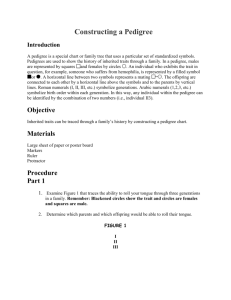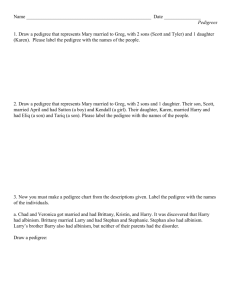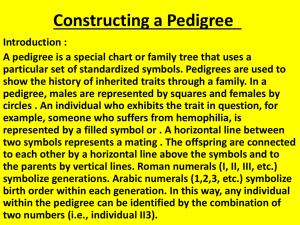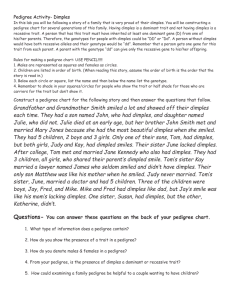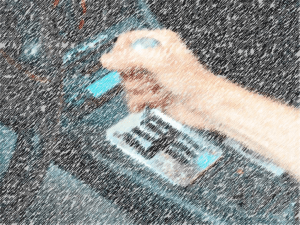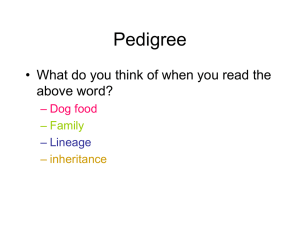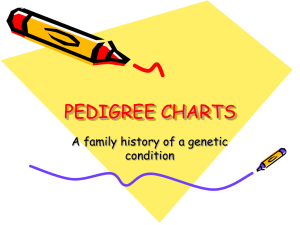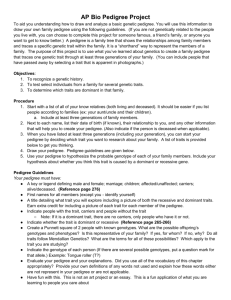File - PECHS PAP Biology
advertisement
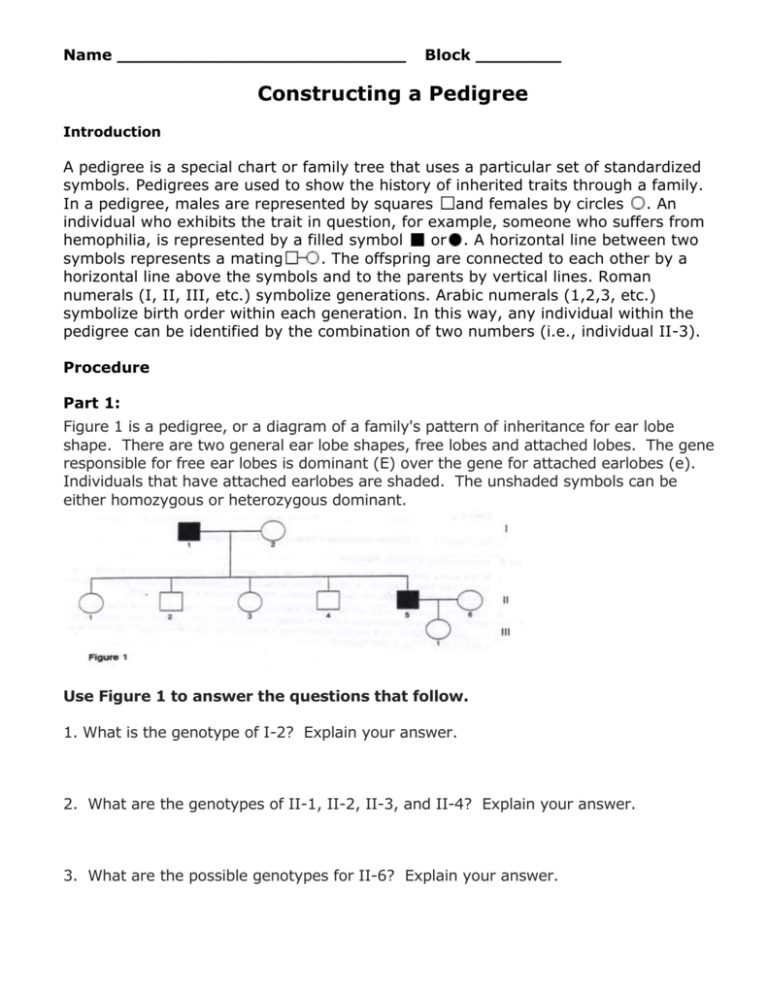
Name ___________________________ Block ________ Constructing a Pedigree Introduction A pedigree is a special chart or family tree that uses a particular set of standardized symbols. Pedigrees are used to show the history of inherited traits through a family. In a pedigree, males are represented by squares and females by circles . An individual who exhibits the trait in question, for example, someone who suffers from hemophilia, is represented by a filled symbol or . A horizontal line between two symbols represents a mating . The offspring are connected to each other by a horizontal line above the symbols and to the parents by vertical lines. Roman numerals (I, II, III, etc.) symbolize generations. Arabic numerals (1,2,3, etc.) symbolize birth order within each generation. In this way, any individual within the pedigree can be identified by the combination of two numbers (i.e., individual II-3). Procedure Part 1: Figure 1 is a pedigree, or a diagram of a family's pattern of inheritance for ear lobe shape. There are two general ear lobe shapes, free lobes and attached lobes. The gene responsible for free ear lobes is dominant (E) over the gene for attached earlobes (e). Individuals that have attached earlobes are shaded. The unshaded symbols can be either homozygous or heterozygous dominant. Use Figure 1 to answer the questions that follow. 1. What is the genotype of I-2? Explain your answer. 2. What are the genotypes of II-1, II-2, II-3, and II-4? Explain your answer. 3. What are the possible genotypes for II-6? Explain your answer. 4. If II-6 is EE, what is the genotype of her child with II-5? 5. What sex is the oldest child in generation II? 6. Who is the youngest child in generation II? 7. Who is the daughter-in-law in this family? 8. How many generations are represented in this pedigree? 9. Explain why you are not always able to determine the exact genotype for the trait of a person when you construct a pedigree. Part 2: Complete the pedigree below. In the spaces below each symbol, write as much of the genotype of each individual as can be determined from the information provided. Assume the shades symbols represent the homozygous recessive genotype rr. R = dominant trait r = recessive trait Questions 1. What type of information does a pedigree contain? 2. How do you show the presence of a trait in a pedigree? 3. How do you denote males & females in a pedigree? 4. How could examining a family pedigree be helpful to a couple wanting to have children? Part 3: Read the passage about the Smith family and their inherited trait of dimples. After reading the passage, construct a pedigree showing all family members in each generation and whether they do or do not have dimples. Once the pedigree is constructed, write the correct genotype by each person in the family. Grandfather and Grandmother Smith smiled a lot and showed off their dimples each time. They had a son named John, who had dimples, and daughter named Julie, who did not. Julie died at an early age, but her brother John Smith met and married Mary Jones because she had the most beautiful dimples when she smiled. They had 5 children, 2 boys and 3 girls. Only one of their sons, Tom, had dimples, but two girls, Judy and Kay, had dimpled smiles. Their sister June lacked dimples. After college, Tom met and married Jane Kennedy who also had dimples. They had 3 children, all girls, who shared their parent’s dimpled smile. Tom’s sister Kay married a lawyer named James who seldom smiled and didn’t have dimples. Their only son Matthew was like his mother when he smiled. Judy never married. Tom’s sister, June, married a doctor and had 5 children. Three of the children were boys, Jay, Fred, and Mike. Mike and Fred had dimples like dad, but Jay’s smile was like his mom’s lacking dimples. One sister, Susan, had dimples, but the other, Katherine, didn’t. 1. From your pedigree, is the presence of dimples a dominant or a recessive trait?
